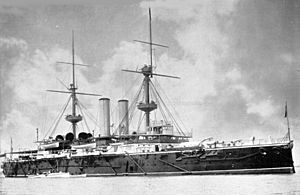Naval Defence Act 1889 facts for kids
| Act of Parliament | |

|
|
| Citation | 52 & 53 Vict. c. 8 |
|---|---|
| Dates | |
| Royal assent | 31 May 1889 |
The Naval Defence Act 1889 was an important law passed by the Parliament of the United Kingdom. It became official on May 31, 1889. This Act made a rule called the "two-power standard" official. It also greatly increased the strength of the United Kingdom's navy.
The "two-power standard" meant that the Royal Navy had to have as many battleships as the next two biggest navies combined. At that time, these were the navies of France and Russia. The Act provided an extra £20 million over four years. This money was used to build ten new battleships, thirty-eight new cruisers, eighteen new torpedo boats, and four new fast gunboats. Britain kept this "two-power standard" until countries started reducing their weapons between World War I and World War II.
Contents
Why the Act Was Needed
This law was passed when Lord Salisbury was leading the government. It allowed the government to spend £21.5 million over five years to make the navy much bigger. At first, some members of Parliament were against spending so much money on the navy.
However, naval experts told Parliament in late 1888 and early 1889 that the British navy was not strong enough. They pointed out that the French and Russian navies were growing. Because of this, more and more people in Britain wanted the navy to grow stronger. This public support put pressure on Parliament to approve the Act.
Actually, Britain had been using the "two-power standard" unofficially for about seventy years. Britain already had the strongest navy in the world. This Act just made the standard official. It also showed that Britain wanted to make its naval power even greater.
Building More Warships
The Act led to a big increase in the number of warships. Ten battleships, forty-two cruisers, and eighteen torpedo gunboats were ordered. The battleships were the most important part of this plan.
Eight very powerful battleships were ordered. Seven of these were from the Royal Sovereign class, and one was HMS Hood. Two smaller battleships, HMS Centurion and HMS Barfleur, were also ordered. The Royal Sovereign class ships were the most powerful warships of their time. No ships from Russia or France could match them. The cruisers were built to protect Britain's important shipping routes.
Nine large cruisers of the Edgar class were built. Also, twenty-nine medium-sized cruisers from the Apollo and Astraea classes were added. Four smaller cruisers of the Pearl class were also included. The eighteen torpedo gunboats were meant to support and protect the main battle fleet.
Reasons for the Act
There were two main reasons for this Act: military and economic. Lord George Hamilton, who was in charge of the navy, said that building so many new ships would stop other countries from trying to build up their own navies. He believed that if Britain built a strong navy now, it would not have to spend as much money on shipbuilding in the future.
The Act also offered immediate economic benefits. Parliament quickly approved a large amount of money, guaranteed for five years. Before this, shipbuilding projects often stopped because there wasn't enough money each year. When funds ran out, building ships took longer and cost more. By funding the expansion over five years, any money left over from one year could be used the next year. This allowed production to continue without stopping, which saved a lot of money. This also meant Britain could finish its warships faster than its rivals. The idea was that building ships quickly and in large numbers would not only save money but also discourage other countries from trying to catch up.
What Happened Next
In the end, the Act had some economic success but failed to stop other countries from building up their navies. Funding the warships over five years meant that production continued smoothly. There were only small cost increases and few delays. At the same time, there was a high demand for merchant ships, which were built in the same shipyards. This meant that the cost of workers and materials did not go up much.
However, Lord George Hamilton's hope of spending less on the navy in the future did not come true. Soon, France and Russia started building just as many ships as Britain. While Britain had finished 10 battleships and had 3 more being built or planned, France and Russia had started building a combined 12 battleships, with 3 more planned.
Another British naval expansion, called the Spencer Programme, followed in 1894. This program aimed to match the growth of foreign navies and cost over £31 million. Instead of stopping other countries from building more ships, the Act probably helped start a naval arms race. Other powerful countries, like Germany and the United States, also increased the size of their navies in the years that followed, as Britain continued to spend more on its own navy.
See also


